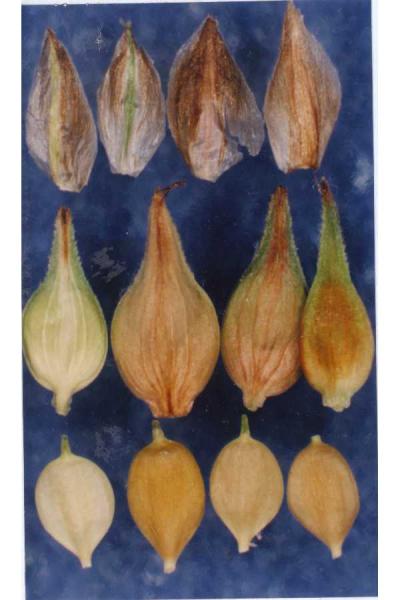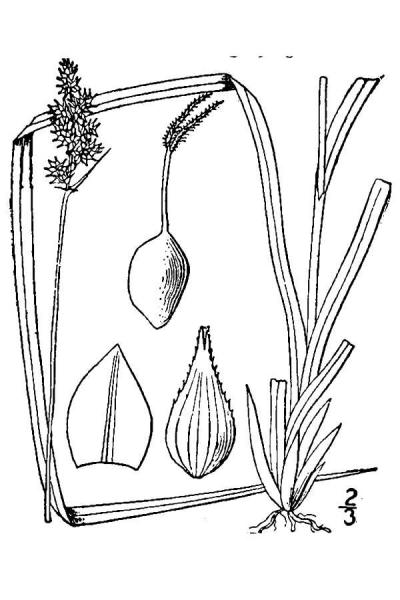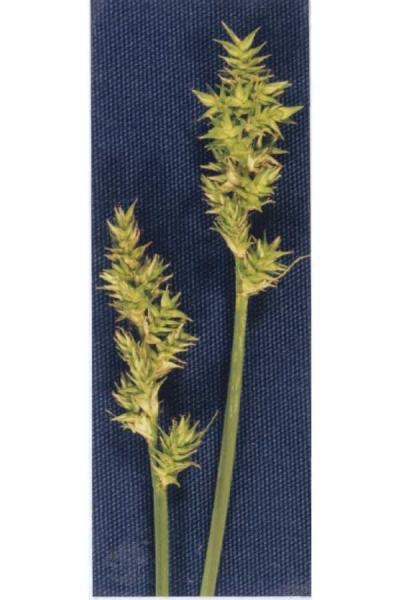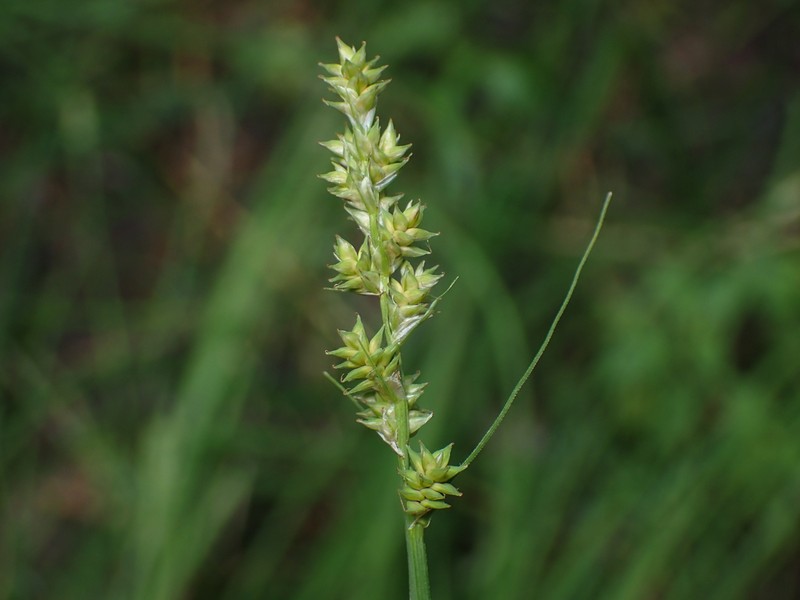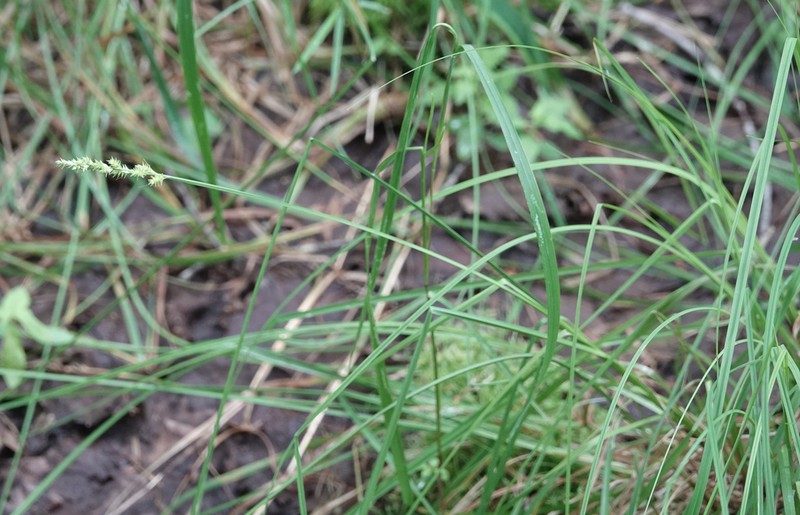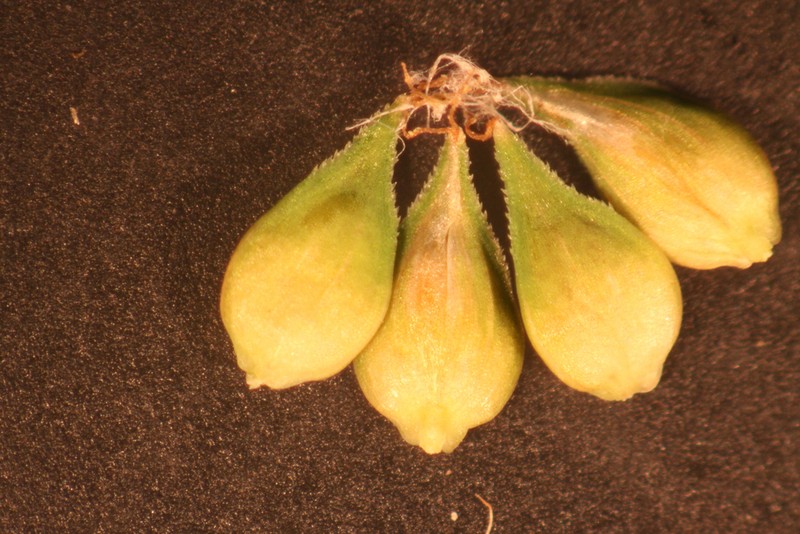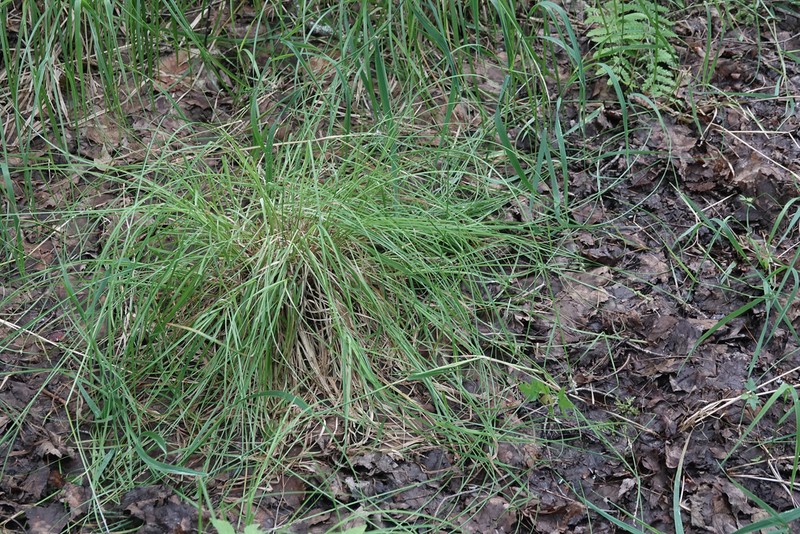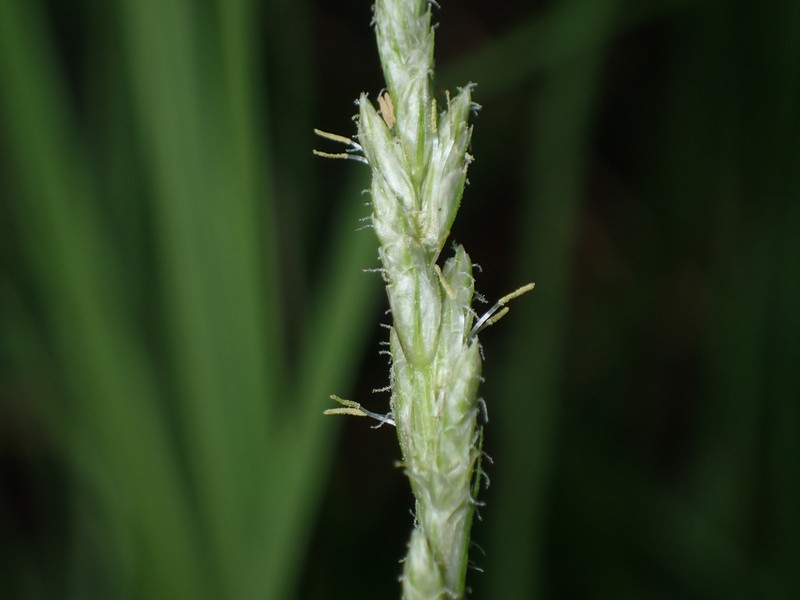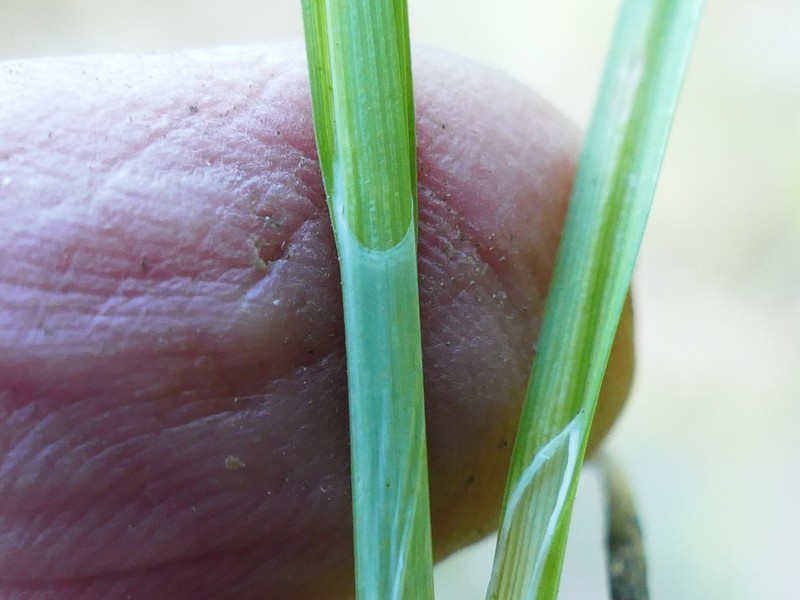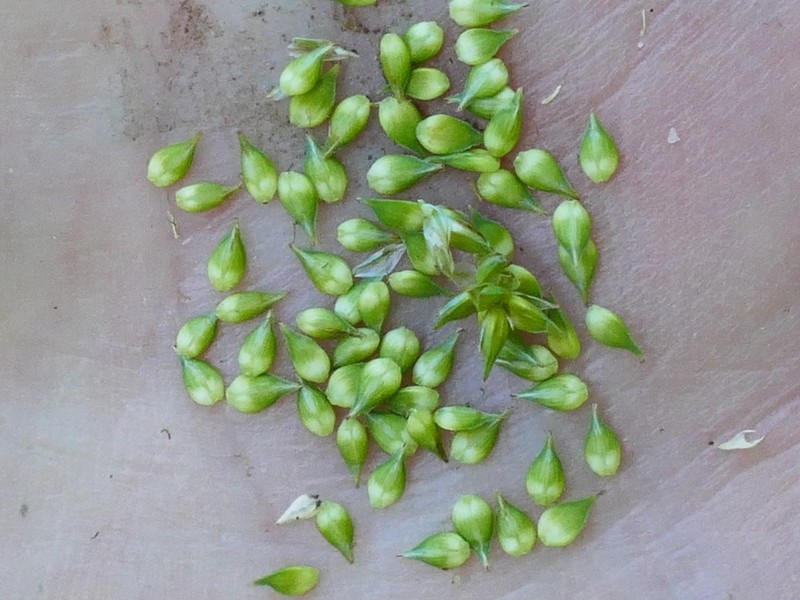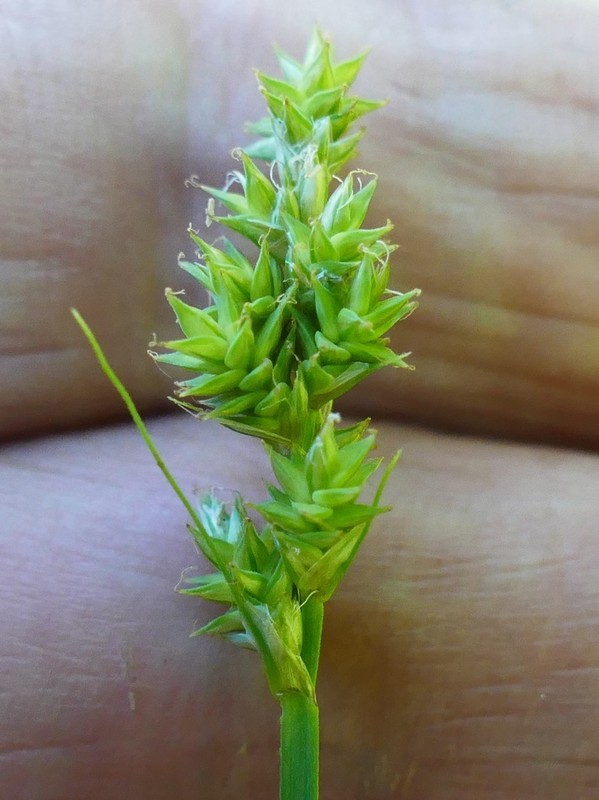Northern Clustered Sedge
Carex arcta Boott
- Class
- Monocotyledoneae (Monocots)
- Family
- Cyperaceae (Sedge Family)
- State Protection
- Endangered
Listed as Endangered by New York State: in imminent danger of extirpation in New York. For animals, taking, importation, transportation, or possession is prohibited, except under license or permit. For plants, removal or damage without the consent of the landowner is prohibited.
- Federal Protection
- Not Listed
- State Conservation Status Rank
- S1
Critically Imperiled in New York - Especially vulnerable to disappearing from New York due to extreme rarity or other factors; typically 5 or fewer populations or locations in New York, very few individuals, very restricted range, very few remaining acres (or miles of stream), and/or very steep declines.
- Global Conservation Status Rank
- G5
Secure globally - Common in the world; widespread and abundant (but may be rare in some parts of its range).
Summary
Did you know?
The species name means "contracted" and refers to the spikelets that are all clustered at the top of the stem.
State Ranking Justification
There is only one known occurrence and less than ten total populations reported across a very broad range of the state. This sedge may be overlooked as its habitat is very common. New York is at the southern limit of its range, so that may account for the limited number of populations reported. Future surveys should focus on the Adirondacks, Tug Hill Plateau, and Allegany Reservoir area. The southern Hudson Valley record needs to be verified.
Short-term Trends
This plant was never common in the state with only three collections after 1950. We need more data about the known population and more searches of historical populations to understand the short-term trend.
Long-term Trends
This plant probably persists in low numbers in the state. We need more searches of the historical populations to better understand the long-term trend.
Conservation and Management
Threats
The known population is in a populated area but its wetland is not directly threatened.
Conservation Strategies and Management Practices
Maintain the wetland habitat where this sedge grows.
Habitat
Habitat
This sedge may be found in low wet woods, along the edges of islands, flats along rivers, swales, around reservoirs and other bodies of water, and other wet depressions (New York Natural Heritage Program 2005). Swampy (coniferous) woods and thickets, wet meadows (Flora of North America 2002). Streambanks, meadows, and other wet places (Gleason and Cronquist 1991). Very local in low usually +/- open ground (Voss 1972). Wet woods, alluvial thickets, shores, and swales (Fernald 1970).
Associated Ecological Communities
- Beech-maple mesic forest*
(guide)
A hardwood forest with sugar maple and American beech codominant. This is a broadly defined community type with several variants. These forests occur on moist, well-drained, usually acid soils. Common associates are yellow birch, white ash, hop hornbeam, and red maple.
- Floodplain forest*
(guide)
A hardwood forest that occurs on mineral soils on low terraces of river floodplains and river deltas. These sites are characterized by their flood regime; low areas are annually flooded in spring, and high areas are flooded irregularly.
- Hemlock-hardwood swamp*
(guide)
A swamp that occurs on mineral soils and deep muck in depressions which receive groundwater discharge. These swamps usually have a fairly closed canopy (70 to 90% cover), sparse shrub layer, and low species diversity. The tree canopy is typically dominated by eastern hemlock and co-dominated by yellow birch and red maple.
- Hemlock-northern hardwood forest*
(guide)
A mixed forest that typically occurs on middle to lower slopes of ravines, on cool, mid-elevation slopes, and on moist, well-drained sites at the margins of swamps. Eastern hemlock is present and is often the most abundant tree in the forest.
- Northern white cedar swamp*
(guide)
A swamp that occurs on organic soils in cool, poorly drained depressions in central and northern New York, and along lakes and streams in the northern half of the state. These swamps are often spring-fed with continually saturated soils. Soils are often rich in calcium. The characteristic tree is northern white cedar, which makes up more than 30% of the canopy cover.
- Shallow emergent marsh*
(guide)
A marsh meadow community that occurs on soils that are permanently saturated and seasonally flooded. This marsh is better drained than a deep emergent marsh; water depths may range from 6 in to 3.3 ft (15 cm to 1 m) during flood stages, but the water level usually drops by mid to late summer and the soil is exposed during an average year.
- Spruce-fir swamp*
(guide)
A conifer swamp that typically occurs in a drainage basin but also can occur at the edge of a lake or pond or along gentle slopes of islands. These swamps are usually dense, with a fairly closed canopy (80 to 90% cover). The dominant tree is usually red spruce. Codominant trees include balsam fir and red maple. In the Catskills, balsam fir may be absent, and in the Adirondacks, black spruce or white spruce may replace red spruce as a dominant tree.
- Successional northern hardwoods*
A hardwood or mixed forest that occurs on sites that have been cleared or otherwise disturbed. Canopy trees are usually relatively young in age (25-50 years old) and signs of earlier forest disturbance are often evident. Characteristic trees and shrubs include any of the following: quaking aspen, big-tooth aspen, balsam poplar, paper birch, gray birch, pin cherry, black cherry, red maple, and white pine.
- Successional old field*
A meadow dominated by forbs and grasses that occurs on sites that have been cleared and plowed (for farming or development), and then abandoned or only occasionally mowed.
* probable association but not confirmed.
Associated Species
- Carex baileyi (Bailey's sedge)
- Carex tribuloides
- Carex vesicaria (lesser bladder sedge)
Range
New York State Distribution
This sedge has a broad distribution that ranges from the southern Hudson Valley, north to the Adirondacks, and west to Allegheny State Park. However, within this broad range less than ten populations have been reported. Today, only one population is known, and it occurs in the Adirondack region.
Global Distribution
This sedge ranges from Quebec to the southern Yukon and Alaska, south to New York, Michigan, Minnesota, and California. It is considered rare or uncommon in about half of this range, with only British Columbia reporting it as secure/common (S5) and Ontario reporting it as apparently secure (S4).
Identification Comments
General Description
Carex arcta is a tightly clumped sedge with short underground stems. The soft stems are about 2 feet high, rough at the top, and often overtopped by the pale or grayish-green, soft, flat, narrow leaves only 1/8" wide. The leaf sheath is conspicuously purple-dotted and concave near the summit. The ligule is pointed and longer than wide. The 5-15 spikes are all clustered together at the tops of the stems. Each spike has 10-20 or more perigynia crowded together. The perigynia are egg-shaped with a definite beak that is strongly toothed. They have obvious nerves on the outside face with faint nerves on the inside face. They are 2-3 mm long and 1.2-1.5 mm wide. The perigynia scales are pointed, slightly shorter than the perigynia, clear with a green center, and often brown-tinged.
Identifying Characteristics
Carex arcta is a densely cespitose plant with short rhizomes. The soft leaf blades are flat, 15-50 cm long and 2-4 mm wide. The sheath is conspicuously purple-dotted and concave near the summit. The ligule is acute and longer than wide. The 5-15 spikes are typically clustered together at the top of the stem or only scarcely separated. Each spike is often crowded into elongated heads with the number of reported perigynia ranging from 10-20 (Flora of North America 2002) to (20-)25-40 (Gleason and Cronquist 1991). The perigynia is broadest just above the base with a strongly toothed beak. The scales are mostly shorter than the perigynia, hyaline with a green center, and often tinged with brown.
Best Life Stage for Proper Identification
This plant should be identified with mature fruit. To verify the identification, a voucher record should be made of the entire plant including roots, stems, leaves, and fruits. Gleason and Cronquist (1991) should not be used to key this plant as you may be steered in the wrong direction. Please use Flora of North America (2002), Voss (1972), or Tucker (1995).
Similar Species
Carex exilis only has a single spike and involuted leaves. Carex sterilis and other New York members of section Stellulatae have 2-8 spikes, these are typically less crowded than Carex arcta, and/or with fewer flowers per head (5-25 per head). Carex tenuiflora has beakless perigynia which are broadest near or just above the middle. This plant is also loosely cespitose with long, slender rhizomes. In the other New York members of this section (Carex brunnescens, C. canescens, and C. trisperma), you will find that at least the lower spikes are separated and not overlapping, and the perigynia are widest near or above the middle.
Best Time to See
This sedge flowers from late May to mid-July, with mature fruits present mid-June to early September. Since mature fruits are needed for identification, surveys should be conducted in July and August when this sedge is likely at its peak fruiting period.
- Fruiting
The time of year you would expect to find Northern Clustered Sedge fruiting in New York.
Northern Clustered Sedge Images
Taxonomy
Northern Clustered Sedge
Carex arcta Boott
- Kingdom Plantae
- Phylum Anthophyta
- Class Monocotyledoneae
(Monocots)
- Order Cyperales
- Family Cyperaceae (Sedge Family)
- Order Cyperales
- Class Monocotyledoneae
(Monocots)
- Phylum Anthophyta
Additional Common Names
- Bear Sedge
- Clustered Sedge
- Contracted Sedge
- Narrow Sedge
- Northern Cluster Sedge
- Sedge
Comments on the Classification
Flora of North America (2002) places this sedge in section Glareosae (formerly section Heleonastes), although earlier texts (e.g. Gleason and Cronquist 1991) placed it in Stellulatae. The main differerence between these sections is all Glareosae members have wholly pistillate lateral spikes while some members of section Stellulatae. In section Glareosae, the achenes do not have a spongy base, generally fill the entire perigynia body, and the perigynia are rounded near the margins. In section Stellulatae, the achenes typically have a spongy base, are distinctly smaller than the perigynial body, and the perigynia have sharp margins.
Additional Resources
Best Identification Reference
Flora of North America Editorial Committee. 2002. Flora of North America, North of Mexico. Volume 23. Magnoliophyta: Commelinidae (in part): Cyperaceae. Oxford University Press, New York. 608 pp.
Other References
Fernald, M.L. 1950. Gray's manual of botany. 8th edition. D. Van Nostrand, New York. 1632 pp.
Gleason, Henry A. and A. Cronquist. 1991. Manual of Vascular Plants of Northeastern United States and Adjacent Canada. The New York Botanical Garden, Bronx, New York. 910 pp.
Holmgren, Noel. 1998. The Illustrated Companion to Gleason and Cronquist's Manual. Illustrations of the Vascular Plants of Northeastern United States and Adjacent Canada. The New York Botanical Garden, Bronx, New York.
Hurd, E.G., N.L. Shaw, J. Mastrogiuseppe, L.C. Smithman, and S. Goodrich. 1998. Field guide to Intermountain sedges. Gen. Tech. Rep. RMS-GTR-10. USDA FS RMRS, Ogden, UT. Courtesy of USDA FS RMRS Boise Aquatic Sciences Lab (http://www.fs.fed.us/rm/boise/teams/shrub/shaw.htm).
Mitchell, Richard S. and Gordon C. Tucker. 1997. Revised Checklist of New York State Plants. Contributions to a Flora of New York State. Checklist IV. Bulletin No. 490. New York State Museum. Albany, NY. 400 pp.
New York Natural Heritage Program. 2010. Biotics database. New York Natural Heritage Program. New York State Department of Environmental Conservation. Albany, NY.
New York Natural Heritage Program. 2024. New York Natural Heritage Program Databases. Albany, NY.
Tucker, Gordon C. 1995. Preliminary keys to Carex (Cyperaceae) in New York State. New York Flora Association Newsletter 6(2):3-18. Available online at: http://nyflora.org/newsletters/newsletter_18.pdf.
Voss, E.G. 1972. Michigan Flora, Part I. Gymnosperms and Monocots. Cranbrook Institute of Science Bulletin 55 and the University of Michigan Herbarium. Ann Arbor. 488 pp.
Weldy, T. and D. Werier. 2010. New York flora atlas. [S.M. Landry, K.N. Campbell, and L.D. Mabe (original application development), Florida Center for Community Design and Research http://www.fccdr.usf.edu/. University of South Florida http://www.usf.edu/]. New York Flora Association http://newyork.plantatlas.usf.edu/, Albany, New York
Links
About This Guide
Information for this guide was last updated on: November 4, 2022
Please cite this page as:
New York Natural Heritage Program. 2024.
Online Conservation Guide for
Carex arcta.
Available from: https://guides.nynhp.org/northern-clustered-sedge/.
Accessed July 26, 2024.
